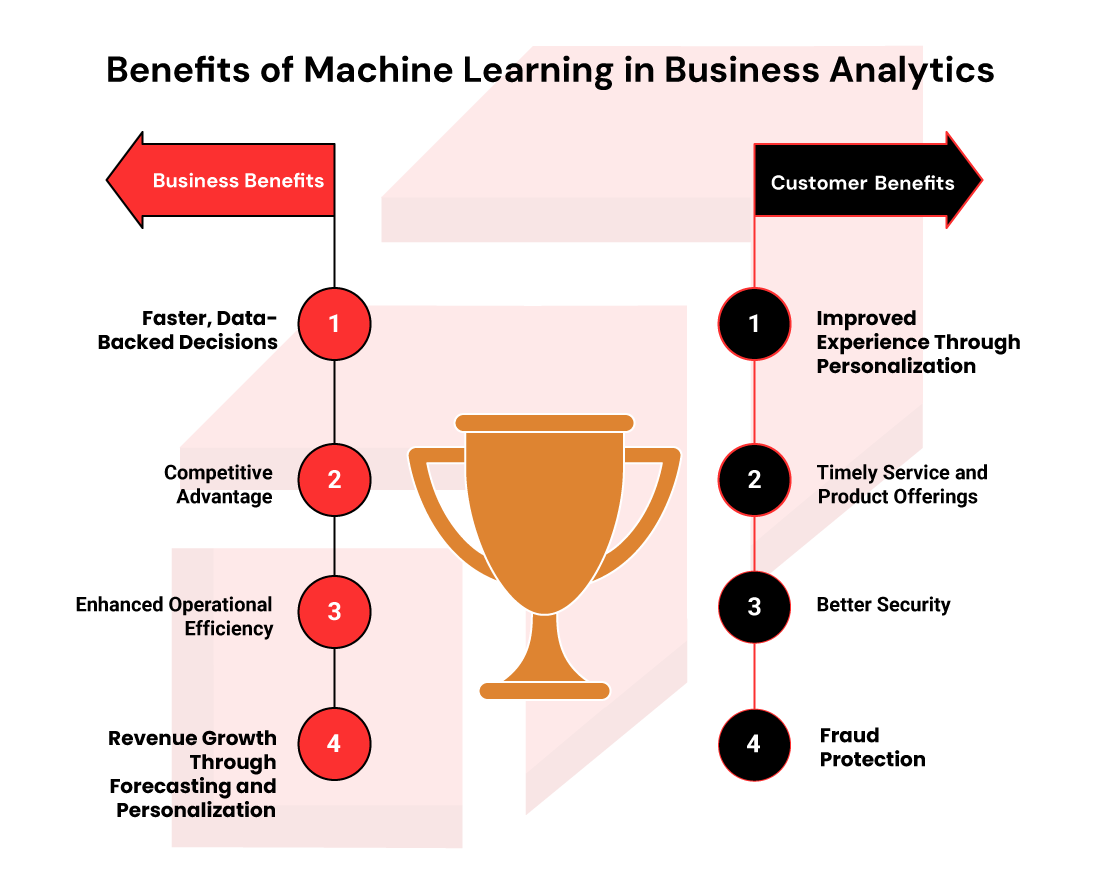“Data is the new oil, but machine learning is the refinery that turns it into fuel for growth.” – Data Scientist, Tech Innovate Summit 2024
Every day, businesses generate a mind-boggling 2.5 quintillion bytes of data: equivalent to streaming 250,000 hours of HD video. While traditional analytics tools help make sense of this flood, they often stop at describing what happened, leaving companies hungry for predictive and actionable insights. Machine learning (ML) bridges this gap, transforming raw data into strategic foresight that drives smarter decisions and competitive edge.
Machine learning is the part of Artificial engine In this blog, we’ll dive into the power of machine learning for business analytics, explore its techniques, uncover transformative use cases, and share a real-world success story, all while highlighting key challenges and the exciting future ahead.
Importance of Data Analytics for Business
Data analytics is the heartbeat of modern business, turning raw numbers into insights that fuel growth. It helps companies understand customer preferences, streamline operations, and spot market trends. For example, a retailer might analyse sales data to optimize stock, while a logistics firm uses analytics to cut delivery times.
Without analytics, businesses risk missing opportunities or making costly missteps. Yet, traditional analytics often looks backward, not forward. ML steps in to predict future trends and prescribe actions, making it indispensable for staying ahead.
“Analytics tells you where you’ve been; machine learning shows you where you’re going.” – Chief Data Officer, Global Retail Chain
What Is Machine Learning in Business Analytics?
Machine learning in business analytics is the use of algorithms that learn from data to uncover patterns, predict outcomes, and deliver actionable insights without explicit programming. It’s like giving your data a brain to think for itself.
By analysing historical and real-time data, ML, often managed through an mlops solution, enables businesses to forecast demand, personalize customer experiences, and optimize processes. For instance, an e-commerce giant like Amazon uses ML to recommend products based on browsing patterns, boosting sales with uncanny precision.
The global ML market in business analytics is projected to reach $29.6 billion by 2027, growing at a CAGR of 43.4%, driven by demand for predictive insights.
Difference Between Traditional Analytics and ML-Based Analytics
To grasp the transformative power of machine learning for business analytics, let’s compare it with traditional methods:
| Aspect | Traditional Analytics | ML-Based Analytics |
| Approach | Rule-based, manual | Self-learning algorithms |
| Data Handling | Structured, smaller datasets | Structured and unstructured, large-scale |
| Insights | Descriptive, historical | Predictive and prescriptive |
| Speed | Slower, human-driven | Fast, automated |
| Scalability | Limited by static models | Scales with complexity |
| Example | Monthly sales reports | Predicting sales trends |
Machine learning for business analytics processes data up to 100 times faster than traditional methods, enabling real-time insights.
Benefits of Machine Learning in Business Analytics

Business Benefits:
- Faster, Data-Backed Decisions: Machine learning for business analytics processes vast datasets instantly, enabling swift decisions, like optimizing delivery routes in real time.
- Competitive Advantage: By predicting market shifts, machine learning helps companies stay ahead of rivals.
- Enhanced Operational Efficiency: Automating tasks like inventory checks, machine learning for business analytics cuts costs by up to 20%.
- Revenue Growth Through Forecasting and Personalization: Accurate predictions and tailored experiences, like Netflix’s recommendations, boost revenue by 15-30%.
“Machine learning for business analytics is our secret weapon for staying ahead.” – CEO, Fintech Startup
Customer Benefits:
- Improved Experience Through Personalization: Machine learning in business analytics delivers tailored content, like Spotify’s playlists, boosting loyalty.
- Timely Service and Product Offerings: Predictive models ensure timely offers, such as Amazon’s just-in-time discounts.
- Better Security and Fraud Protection: Business analytics and machine learning detects transaction anomalies, enhancing customer trust.
Companies leveraging machine learning techniques for improved business analytics see 10-20% higher customer satisfaction scores.
Key Machine Learning Algorithms in Business Analytics
Machine learning for business analytics relies on powerful algorithms:
- Supervised Learning: Regression predicts sales, while classification identifies spam emails.
- Unsupervised Learning: Clustering groups customers for marketing, and anomaly detection spots fraud.
- Reinforcement Learning: Optimizes decisions, like dynamic pricing in ride-sharing apps.
- NLP, Deep Learning, and Ensemble Methods: NLP powers chatbots, deep learning enhances retail image recognition, and ensemble methods boost prediction accuracy.
“Choosing the right algorithm is the key to unlocking machine learning for business analytics.” – Data Analytics Lead, E-Commerce Platform
How to Use Machine Learning in Business Analytics
Implementing the definition of machine learning in business analytics follows a clear process, enabling businesses to harness data effectively:
- Data Collection: Gather data from CRM, IoT, or social media.
- Data Preprocessing: Clean data to ensure accuracy.
- Model Selection: Choose algorithms like regression or clustering based on goals.
- Training and Testing: Train models on historical data and test for accuracy.
- Deployment: Integrate models into workflows, like CRM predictions.
- Monitoring and Iteration: Track performance and retrain models regularly.
Integration with BI Tools: Machine learning for business analytics enhances Tableau, Power BI, or Looker with predictive capabilities, like forecasting churn.
Cloud Platforms and ML APIs: AWS SageMaker, Azure Machine Learning, and GCP Vertex AI simplify adoption of machine learning algorithms in business analytics with scalable infrastructure and pre-built APIs, making advanced analytics accessible to all.
Cloud-based machine learning in business analytics cuts deployment time by 40%, accelerating insights.
Challenges and Considerations Before Adopting ML in Analytics
Adopting machine learning techniques for improved business analytics requires addressing key challenges:
- Data Quality and Availability: Poor data can reduce model accuracy by 30%, necessitating strong governance.
- Talent/Skill Gaps: Lack of expertise can stall projects, requiring training or partners like Rapyder.
- Model Interpretability and Trust: Complex models need explainable AI to build stakeholder trust.
- Integration with Legacy Systems: Older systems may need middleware for ML integration.
- Ethics and Data Privacy Concerns: Compliance with GDPR/CCPA is critical to avoid risks.
“Ethical machine learning for business analytics builds trust and drives adoption.” – Privacy Officer, Tech Firm
Top Use Cases of Machine Learning in Business Analytics
Sunix AI Private Limited, a forward-thinking company in artificial intelligence, transformed its operations by leveraging machine learning for business analytics with Rapyder Cloud Solutions. Facing challenges like labour-intensive data labelling and complex model deployments, Sunix partnered with Rapyder to implement an automated MLOps pipeline using AWS services. [Read More]
“Rapyder’s expertise in machine learning for business analytics transformed our AI workflows, making us faster and more efficient.” – Sunix AI Executive
Future of Machine Learning in Business Analytics
The future of machine learning algorithms in business analytics is dynamic, with transformative trends on the horizon:
- Predictive to Prescriptive Analytics: Machine learning for business analytics will evolve to recommend specific actions, like optimal marketing strategies.
- Rise of AutoML and Citizen Data Scientists: AutoML will drive 70% of businesses to adopt ML by 2028, empowering non-experts.
- Real-Time Analytics: Instant insights, like fraud detection, will become standard.
- Responsible AI: Ethical frameworks will ensure fairness, with 90% of enterprises adopting by 2030.
By 2027, 85% of enterprises will leverage real-time machine learning for business analytics, up from 40% in 2025.
Conclusion
Machine learning for business analytics is a game-changer, turning data into predictive and prescriptive insights that drive growth. From forecasting to personalization, it empowers businesses to thrive. Rapyder’s success with Sunix AI Private Limited showcases its real-world impact.
Ready to unlock machine learning for business analytics?
FinOps consultation







